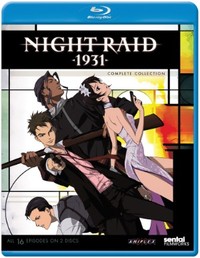Shelf Life
The Manchurian Candidate
by Erin Finnegan,

Night Raid 1931 BD
Sgt. Frog season 3 part 1 DVD
Rental Shelf
Utakata Complete Series DVD
Perishable
Nothing this time
Along those lines, sometimes “new additions” to Rentanime.com's selection are not always so new. That may be why I rented Utakata to review this week, even though the DVD was released several months ago.
 Man, this was a weird show. I thought I knew where Utakata was going from episode one. I was prepared to write a review like, “this was the most generic show that ever genericked” (to coin a phrase), but then Utakata pitched a curve ball straight into my brain.
Man, this was a weird show. I thought I knew where Utakata was going from episode one. I was prepared to write a review like, “this was the most generic show that ever genericked” (to coin a phrase), but then Utakata pitched a curve ball straight into my brain.When a weird magic chick named Manatsu (who looks a little like Hatsune Miku) emerges from a mirror at school, ordinary 14-year-old Ichika Tachibana is in for one crazy summer she'll never forget! Or that would be the plot, if this show wasn't about sad girls moping around, often with issues of an after-school special caliber (abusive boyfriends, for example).
Ichika gets a bracelet with twelve jewels on it, and which allows her to transform into a magical girl with a different outfit for each of twelve Djinns. (In this show, Djinn have god-like powers -- you've got your ocean Djinn, your sun Djinn, etc.). Strangely, Ichika's costumes are sometimes laughably out of place for a show with such a somber tone. The plot immediately reminded me of Prétear, but rather than half-a-dozen boys, Utakata has only two cuties, Ichika's twin tutors.
The first six episodes cover the requisite beach trips involved in any Japanese summer. Things take a turn for the dark in episode seven as the show heads more towards a murky coming-of-age tale.
Most girls seem happy enough to get magical girl powers, or at least cheerfully reluctant, but Ichika just keeps getting more depressed. The show winds up being about adolescent self-discovery and self acceptance. I don't mind those themes, but the awkward writing makes Utakata a slog to get through.
Frankly, I was confused by the number of panty shots in this show. There weren't enough for soft-core porn, yet there were too many to be innocent like Kiki's Delivery Service. It just wound up feeling creepy, especially with such sad girls as the subject of up-skirt angles.
Theron gave the animation a C+, and although I agree that this was a simple-looking show with a low-ish budget, I didn't notice animation mistakes (like foot sliding or characters drawn off-model). Rather, I think the unmemorable character designs and weak writing led to an overall milquetoast series. Theron praised the show's music, and although I agree the music was alright, I didn't think it was particularly memorable.
In fact, almost nothing about this show is memorable, save for a very brief scene when it looks like Ichika has turned bulimic(!). There is also an almost-memorable-because-it's-so-cheesy line where Ichika is crying about being a bad person and confesses dramatically, “I've even littered!”
If you're a fan of seiyuu, the DVD includes the Japanese extras where two of the voice actresses travel to different places in Kamakura that are featured as locations in the show. The seiyuu may act like goofballs, but oddly these extras are exactly what it's like to tour Japan. The actresses tell you what to do at particular shrines and give quick history facts about each area, and then proceed to eat the local food specialty. [TOP]
I wonder how long it will take me to forget Utakata. Fortunately everything else I watched this week left a lasting impression. I watched Night Raid 1931 with my mom on a brief trip home, and she liked it.
 This is the kind of show that makes me glad I write Shelf Life. I might have missed this fine series left to my own devices (mostly because of the ESPer premise). Night Raid 1931 overflows with well-directed action scenes, well written characters, beautiful background artwork, dramatic tension that is well thought out, and I even learned some history before it was through.
This is the kind of show that makes me glad I write Shelf Life. I might have missed this fine series left to my own devices (mostly because of the ESPer premise). Night Raid 1931 overflows with well-directed action scenes, well written characters, beautiful background artwork, dramatic tension that is well thought out, and I even learned some history before it was through.I was thrown off by the psychic powers premise at first. Fortunately, the stellar writing uses the characters' psychic powers just enough to justify the genre choice without turning this into an X-Men plot. Aoi has telekinesis that allows him to use short blasts of energy to move objects (like bullets). Kazura can teleport anywhere he can see, but he's hesitant to use his powers. Yukina can read minds, and her servant Natsume has eyes so sharp he can see through walls. Thus established, our crack team of psionicists is brought together in pre-WWII Shanghai by a portly bureaucrat named Mr. Sakurai to perform top secret specialty work for the Japanese government.
The show primarily concerns the real life events surrounding the Manchurian Incident (a.k.a. the Mukden Incident) which I didn't know anything about beforehand. In 1931, the Japanese were settling Manchuria, which they obtained as part of the resolution to the Russo-Japanese War. Manchuria happened to have a lot of raw materials and farming potential and would eventually become an important resource for Japan during World War II. Bored? Well, all of the history and political talk in the show is intelligent, and laid out in a suspenseful, intriguing way that tells you just enough to make sense without getting dull or dry. (I read Wikipedia to learn more about Manchuria later, but I was thankful the show was self-contained since I was watching it at my parents' dial-up-internet house.)
Night Raid does a comprehensive job of painting a picture of the political scene in 1931. If you're into historical fiction, you won't want to miss all the talk about Pan-Asianism and Rudyard Kipling quoting. By the end of the series the psychic powers seem like a vehicle to add present-day perspective to a World War II story (in a good way). They're also an excuse for well-directed action scenes.
Plus the animation is great. I was particularly enamored of the character design. Aoi and Kazura's designs reflect their odd couple personality; Aoi's mussed-up hair and one permanently cocked eyebrow demonstrate his individualism, while Kazura's flawless black suit (rocking it Roger Smith style) and perfect hair reflect his attitude about gentlemanly ideals and following rules. The backgrounds are filled with great detail (including famous period paintings in one episode), lending the show a polished look.
For the most part, Night Raid does a great job of staying within the limitations of a 13 episode series. There are just the right number of characters, and the pacing is exact. That said, I wasn't totally sold on the show until episode five. I could do without the cat chase comedy in episode four, and the first OVA episode seemed somewhat superfluous. The ending is satisfying without being completely gratifying.
The dub is spot on. Greg Ayres was born to play Aoi (this is easily my favorite Ayres performance so far). That is great acting and great casting.
I wish this show came in a Blu-ray and DVD dual pack, but we're not so lucky. It happens I had the separate DVD and BD releases on hand, so I watched the DVD on an HDTV at my parents' place and compared it to the Blu-ray when I got back home. There is definitely some pixilation noise on the DVD, but you won't notice it in a standard definition set-up. The BD looks very sharp, maybe even a little too sharp for some of the character art (I thought Kazura was more attractive in SD, somehow). If you think this is worth owning, you may as well pick up the BD.[TOP]
My mom cleverly pointed out that both Night Raid 1931 and Sgt. Frog are about invasions: Japan is invading China; frogs are plotting to overthrow the earth.
 I really like Sgt. Frog, especially the dub. I feel a twinge of guilt saying that Season 3 part 1 is Shelf Worthy if Funimation is just going to put out a complete third season eventually, like they did with seasons one and two. But it's only a twinge. Watching more than 12 episodes of hyperactive frogs in one sitting might get to be a bit much even for me.
I really like Sgt. Frog, especially the dub. I feel a twinge of guilt saying that Season 3 part 1 is Shelf Worthy if Funimation is just going to put out a complete third season eventually, like they did with seasons one and two. But it's only a twinge. Watching more than 12 episodes of hyperactive frogs in one sitting might get to be a bit much even for me.I mentioned last time that it seemed like Sgt. Frog had run out of the usual holidays and was down to Setsubun. Now at the 50+ episode mark the characters introduce a reverse aging gun just so they can celebrate Children's Day. Fresh out of holidays, the show then goes on to parody more anime, film and TV genres, including a classic locked-door mystery, phantom thief anime, 1970's shojo tennis titles, inspiring high school teacher stories, and a cop drama cleverly titled by the translation team as “Shield Law and Order with The Wire from Crime Scene Investigator's Cold Case Files: Special Visitor's Unit. Life on the Streets”. (The original Japanese title is shorter.)
My favorite episode in this set is 58A, where the frogs bid to take over Earth by manufacturing soft drinks to sell in proprietary vending machines. I watched the episode several times, dubbed, subbed, and a third time through just to watch it with my husband. Although admittedly 58A isn't watch-it-a-million-times funny, I think it's a great example of comedy writing for cartoons (even American cartoons). The humor grows organically out of the characters' personalities, and it manages to be funny with references to everyday life (instead of pop culture) that will probably age well over time. The dub script is also particularly strong for that episode.
By comparison the writing in episode 65B is weak. A new character who's cuter than Tamama (as if that's even possible!) appears for just one show and causes trouble. It just doesn't work, since the inciting action and gags don't originate with the protagonists. (That's exactly the kind of plot they warn you not to pitch for ongoing American cartoon shows, by the way.) Not every episode in this set is a winner, but the stronger episodes easily outshine the weaker stories.
Episodes 60A and 62B stand out with good writing. In 60A, Kululu's shrink ray allows for a house-wide miniature grand prix in tiny cars (except Tamama drives a floating slice of cake). In episode 62B, the frogs fill the house with breathable water, the atmosphere of planet Akatawa, and everyone swims around and has a nice time. Straying from the alien invasion premise a little, these episodes are pleasant, whimsical diversions. They're like what a kid might imagine on a rainy day, stuck indoors. The all-underwater swimming in episode 62B is particularly well animated, too.
Is it just me, or have the dub script writers toned it down a shade for the third season? I seem to remember a higher quantity of English-only jokes in season two, but maybe I imagined it. It also sounded to me as if Dororo had a new dub voice, but again, maybe I'm just imagining things.[TOP]
That's all for this week! Next week, I'll probably revisit Twelve Kingdoms for the BD release. Please look forward to it!

This week's shelf is from the MIT Anime Club, courtesy of former librarian Jennifer:
"Hey Shelf Life!
I'm a former librarian for the Massachusetts Institute of Technology's Anime Club (better known just as MIT Anime) in Cambridge, MA; our club's been around for 21 years and has subsequently accumulated a lot of... stuff, which I wanted to share with your readers!
We think that MIT Anime has the largest circulating physical library of (legal) anime in the United States, although it hasn't really been proven (so we'd love to know what contenders exist at other college clubs!). As of today, our collection consists of 2,386 DVDs, 347 music CDs, 1,509 books or volumes of manga in various languages, 508 VHS tapes, a bunch of laser discs (!!) and... 4 Blu-Rays, but we're working on that. The full catalog is available on our site at anime.mit.edu if anyone is REALLY interested. We've amassed our collection over the years through some school funding and a TON of generous donations by club officers, students, and members of the public.
We are still hoping to expand our space to fit more items (and become more Genshiken-like), since there are still quite a number of series we want but don't have the space for; wish us luck!"


Awesome! Thanks for showing us these shelves!
Want to show off your stuff? Send your jpgs to [email protected]. Thanks!
discuss this in the forum (46 posts) |